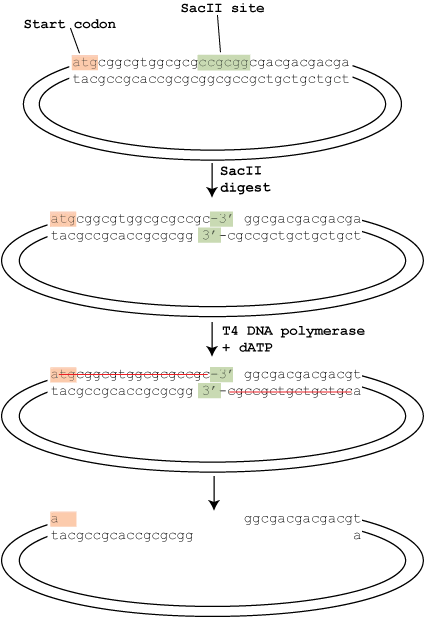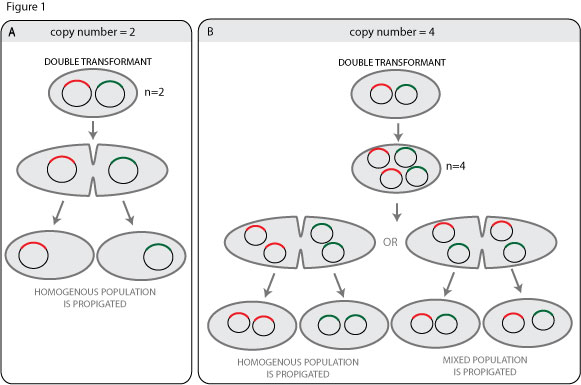Overnight ligations are inconvenient — especially when they fail. Luckily, there’s a straightforward way to faster DNA ligations. This article highlights the secret ingredient to faster ligation reactions and offers some tips and caveats on its use. For a general overview of DNA ligations, see here and here.
Buy a Quick Ligation Kit
The most convenient way to perform faster ligations is to buy a quick ligation kit, such as one of these:
- Ligafast Cloning System (Promega)
- Quick Ligation Kit (New England Biolabs)
- Rapid DNA Ligation Kit (ThermoFisher)
- DNA Ligation Kit, Mighty Mix (Clontech)
These kits enable 5- to 15-minute ligations at room temperature. What’s the secret behind these faster ligation reactions? A simple addition to the ligation reaction buffer: polyethylene glycol (PEG).
How Does PEG Make Ligations Faster?
PEG is an inert polymer that comes in many sizes, ranging from low molecular weight (MW) forms to much larger MW forms. This is the key behind PEG: it makes ligation reactions faster by simply removing empty space in your ligation reaction, a phenomenon called macromolecular crowding or volume exclusion. [1] Other crowding agents (e.g., Ficoll, albumin) exert similar effects, but not as potently as PEG. [1, 2] By excluding volume from your ligation reaction, you increase the effective concentration of DNA termini, making it much more likely that they’ll associate and be ligated by your ligase.
But why does this work? Interestingly, crowded reaction conditions better reflect the intracellular environments in which many enzymes, including DNA ligases, operate endogenously. [1] Thus, it follows that such enzymes would be highly efficient under such conditions, particularly when compared to the artificially sparse conditions found in typical ligation reactions. This difference is most striking in the case of blunt-end ligations, which occur at much lower frequencies than their sticky-end counterparts.
How to Make Your Own Buffer for Faster Ligations
Buying a quick ligation kit may be convenient, but convenience generally comes with a cost. For a more economical solution (no pun intended), use the following recipe as a starting point:
2x Buffer for Faster Ligations [3]:
- 132 mM Tris (pH 7.6)
- 20 mM MgCl2
- 2 mM DTT
- 2 mM ATP
- 15% PEG (MW 6000)
When customizing your own quick ligation reactions, keep the following tips in mind:
- The use of high MW PEGs is critical, as lower MW PEGs do not confer any reaction benefits. [1] Typically, PEG-6000 is used (anything between 3000 and 8000 should work fine).
- Do not use too much (or too little) PEG. Start with 5-7.5% PEG (final concentration) and avoid going over 10%. The recipe above has a final PEG concentration of 7.5%.
- Higher concentrations of DNA ligase and divalent cations (e.g., Mg2+) will favor the formation of intermolecular ligation products. [4] This is good because plasmid DNA ligations require intermolecular ligation between the insert and vector first. This is likely why NEB’s quick ligation buffer contains tenfold more MgCl2 than its standard DNA ligase buffer. However, excess ligase/cations will inhibit the next step, where the ligation product is circularized by intramolecular ligation. Avoid excessive amounts of ligase and divalent cations.
Troubleshooting PEG-Containing Ligation Reactions
Although PEG delivers faster ligation reactions, it can decrease the efficiency of bacterial transformations under certain conditions. Although the mechanisms that underlie this phenomenon are still unknown, it is possible that conditions such as heat and incubation time favor the formation of long DNA concatemers over circularized DNA. [2, 5]
- Do not let your ligation reaction exceed 2 hours. Typically, all you need is 5 minutes for sticky-end ligations and 15 minutes for blunt-end ligations.
- DO NOT HEAT INACTIVATE. Although it is recommended for some ligation reactions, heat inactivation of PEG-containing reactions will cause your transformations to fail.
- When in doubt, clean up your reaction before transformation. This can be done by spin column, precipitation, or drop dialysis. This is absolutely required when using electroporation to transform your bacteria. For other transformation methods, clean up may not be required; in fact, PEG may actually confer a mild stimulatory effect in such cases. [6]
Need more tips on DNA ligations? See here and here. Looking to forego ligations altogether? Check out this ligation-independent cloning method.
References
- S. B. Zimmerman, B. H. Pheiffer, Macromolecular crowding allows blunt-end ligation by DNA ligases from rat liver or Escherichia coli. Proc Natl Acad Sci U S A 80, 5852-6 (1983).
- S. B. Zimmerman, B. Harrison, Macromolecular crowding accelerates the cohesion of DNA fragments with complementary termini. Nucleic Acids Res 13, 2241-9 (1985).
- Datasheet for New England Biolabs’ Quick Ligation Kit (PDF).
- K. Hayashi, M. Nakazawa, Y. Ishizaki, N. Hiraoka, A. Obayashi, Regulation of inter- and intramolecular ligation with T4 DNA ligase in the presence of polyethylene glycol. Nucleic Acids Res 14, 7617-31 (1986).
- D. Louie, P. Serwer, Effects of temperature on excluded volume-promoted cyclization and concatemerization of cohesive-ended DNA longer than 0.04 Mb. Nucleic Acids Res 19, 3047-54 (1991).
- B. H. Pheiffer, S. B. Zimmerman, Polymer-stimulated ligation: enhanced blunt- or cohesive-end ligation of DNA or deoxyribooligonucleotides by T4 DNA ligase in polymer solutions. Nucleic Acids Res 11, 7853-71 (1983).





